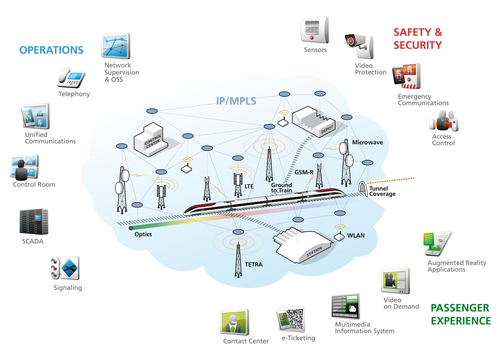By Susan J. Campbell
The concept of innovative next generation communications does not always address the potential in railway telecoms infrastructure; but by ignoring the potential in this space, opportunities for unexploited synergies between the railway telecoms infrastructure and passenger communications are lost.
A recent Alcatel-Lucent white paper, Dynamic Communications for Innovative Railway Transport, explores the business case for adopting new systems as it changes by the maturing of enabling technologies. The migration to an LTE-supported wireless backbone offering multiple services leverages key technologies that are already being tested and validated. Initially, this offering was used for innovative applications; soon it will be capable of acting as the data bearer for signaling systems in the future.
It is recommended that the railway system start preparing for these changes today. With the transition to wireless multi-service networks, it is increasingly essential that rail operators have access to network coverage that is self-sufficient. Broadband wireless services offering faster, more robust networks can enable railway operators to leverage dynamic communications and add value for their passengers.
Transportation customers in the railway industry can benefit from the proliferation of the smartphone usage market. Worldwide, this market is expected to grow 49.2 percent in 2011. It is currently growing four times faster than the overall mobile phone market. As a result, an increasing proportion of railway users have access to data services and applications while on the go.

Railway passengers often view their journey as simply an extension of their time in the office. They need access to dynamic communications to make the most of their transportation time. With access to increasingly-sophisticated devices, rail users should have the opportunity to make their time on the rails that much more productive. Railway providers can capitalize on these opportunities, but they must be able to meet the dynamic communications needs of their passengers.
Unified platforms help to combine passenger connectivity and enhanced information services, while also improving operational performance, efficiency and flexibility of the infrastructure in a single platform. More exciting possibilities are on the horizon with innovations such as lightRadio and the 400Gb/s FP3 router developed by Bell Labs.
According to Libor Lochman, the Community of European Railways (CER) deputy executive director, the interoperability between different network systems and technologies will enable this drive toward improved efficiencies. With the slow pace of adoption, even the technologies being put in place today will need to rapidly change.
“Today it is on the basis of GSM-R, but in 10 years time there will be a need for change in the communications technology when in 2025 the GSM system will no longer be supported,” Lochman said in the white paper. “Railway associations and individual companies are now investigating options that are commercially available and could be used in future signaling equipment.”
The need for dynamic communications is not going to change within the railway space. To enable optimal transportation choices for the professional on the go, integrated innovations are a must.








